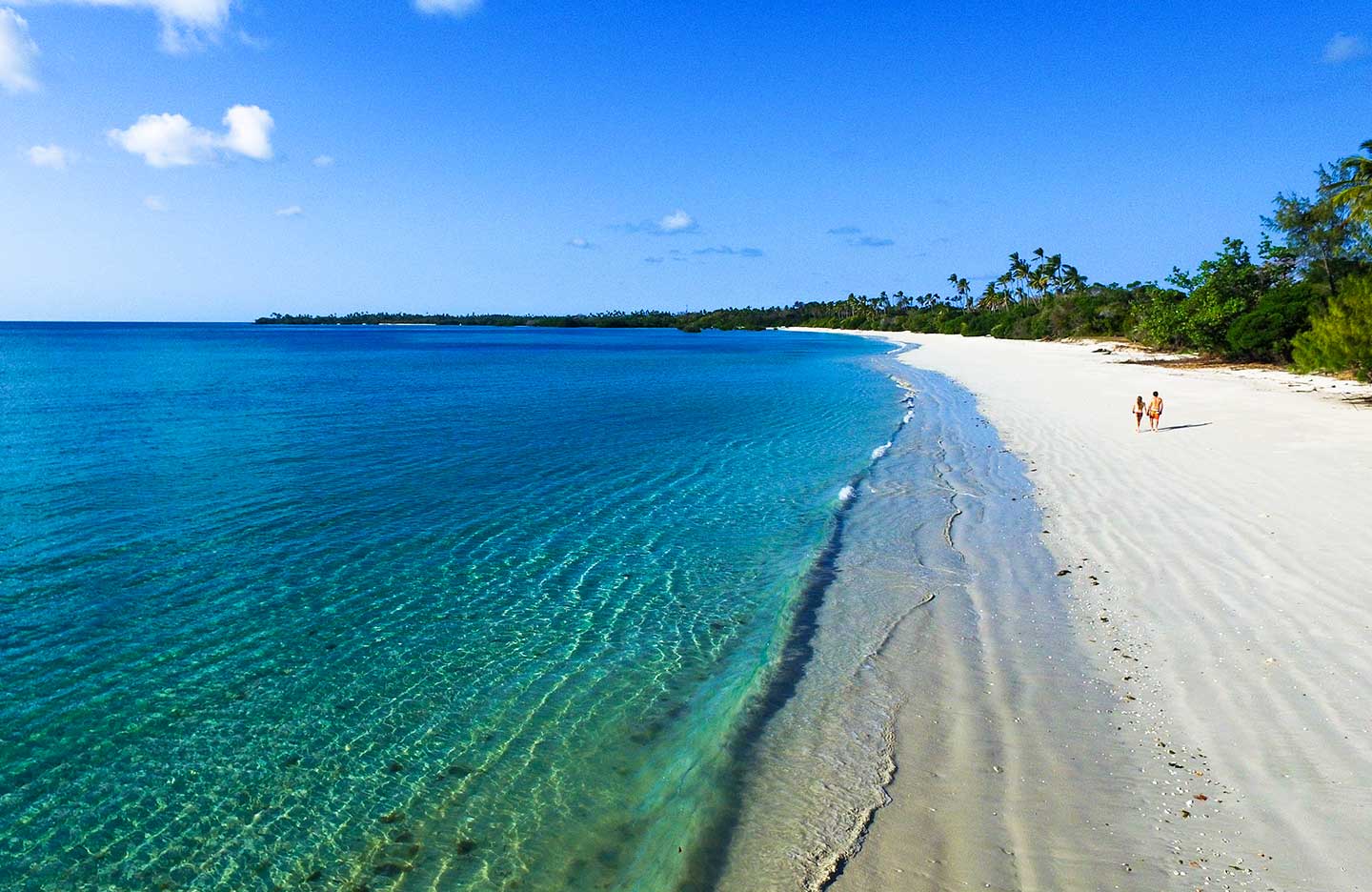Destinations
ARUSHA NATIONAL PARK
The closest national park to Arusha town, northern Tanzania’s safari capital, Arusha National Park is a multi-faceted jewel, often overlooked by safari goers, despite offering the opportunity to explore a beguiling diversity of habitats within a few hours.
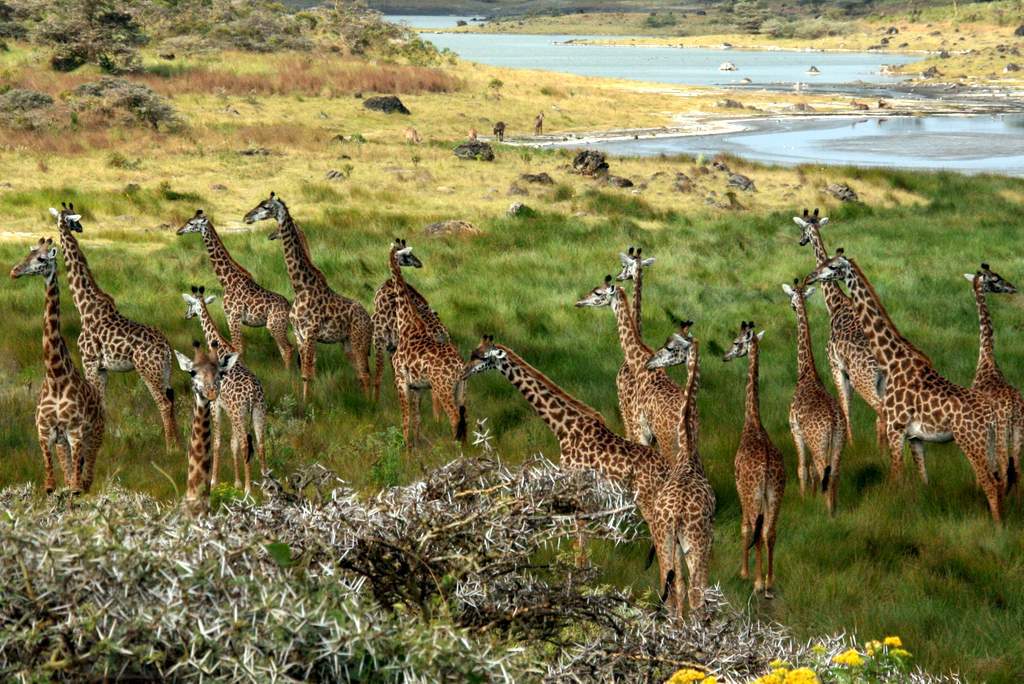
Black-and-white Colobus monkey
The entrance gate leads into shadowy montane forest inhabited by inquisitive blue monkeys and colourful turacos and trogons – the only place on the northern safari circuit where the acrobatic black-and-white Colobus monkey is easily seen. In the midst of the forest stands the spectacular Ngurdoto Crater, whose steep, rocky cliffs enclose a wide marshy floor dotted with herds of buffalo and warthog.
Momella Lakes
Further north, rolling grassy hills enclose the tranquil beauty of the Momella Lakes, each one a different hue of green or blue. Their shallows sometimes tinged pink with thousands of flamingos, the lakes support a rich selection of resident and migrant waterfowl, and shaggy waterbucks display their large lyre-shaped horns on the watery fringes. Giraffes glide across the grassy hills, between grazing zebra herds, while pairs of wide-eyed dik-dik dart into scrubby bush like overgrown hares on spindly legs.
Mount Meru
Mount Meru, the fifth highest in Africa at 4,566 metres, dominates the park’s horizon. Its peaks and eastern foot slopes protected within the national park, Meru offers unparalleled views of its famous neighbour Mount Kilimanjaro, while also forming a rewarding hiking destination in its own right.
View on Kilimanjaro
Passing first through wooded savannah where buffalos and giraffes are frequently encountered, the ascent of Meru leads into forests aflame with red-hot pokers and dripping with Spanish moss, before reaching high open heath spiked with giant lobelias. Everlasting flowers cling to the alpine desert, as delicately hoofed klipspringers mark the hike’s progress. Astride the craggy summit, Kilimanjaro stands unveiled, blushing in the sunrise.
Tarangire National Park
Day after day of cloudless skies. The fierce sun sucks the moisture from the landscape, baking the earth a dusty red, the withered grass as brittle as straw. The Tarangire River has shrivelled to a shadow of its wet season self. But it is choked with wildlife. Thirsty nomads have wandered hundreds of parched kilometres knowing that here, always, there is water
Herds of up to 300 elephants scratch the dry riverbed for underground streams, while migratory wildebeest, zebra, buffalo, impala, gazelle, hartebeest, and eland crowd the shrinking lagoons. It’s the greatest concentration of wildlife outside the Serengeti ecosystem – a smorgasbord for predators – and the one place in Tanzania where dry-country antelope such as the stately fringe-eared oryx and peculiar long-necked gerenuk are regularly observed. During the rainy season, the seasonal visitors scatter over a 20,000 sq. km range until they exhaust the green plains, and the river calls once more. But Tarangire’s mobs of elephant are easily encountered, wet or dry.
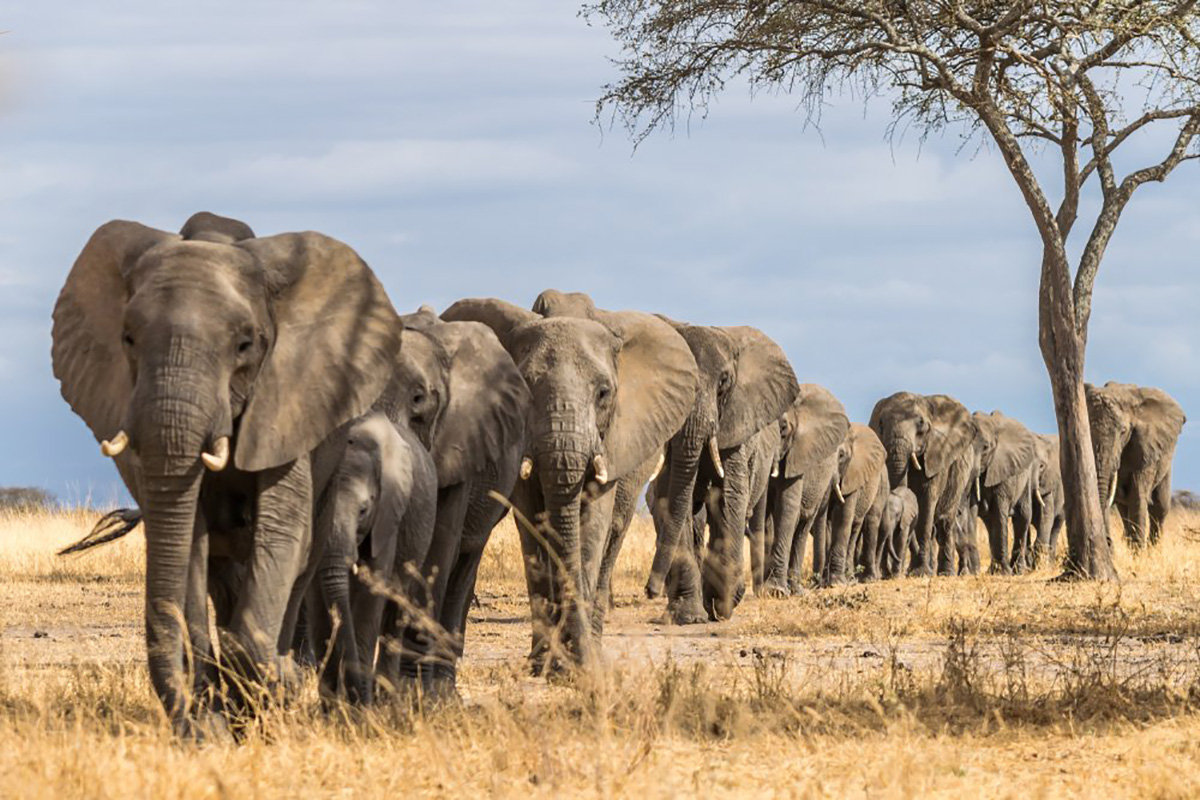
Birdlife
The swamps, tinged green year round, are the focus for 550 bird varieties, the most breeding species in one habitat anywhere in the world. On drier ground you find the Kori bustard, the heaviest flying bird; the stocking-thighed ostrich, the world’s largest bird; and small parties of ground hornbills blustering like turkeys. More ardent bird-lovers might keep an eye open for screeching flocks of the dazzlingly colourful yellow-collared lovebird, and the somewhat drabber rufous-tailed weaver and ashy starling, all endemic to the dry savannah of north-central Tanzania.
Disused termite mounds are often frequented by colonies of the endearing dwarf mongoose, and pairs of red-and-yellow barbet, which draw attention to themselves by their loud, clockwork-like duetting. Tarangire’s pythons climb trees, as do its lions and leopards, lounging in the branches where the fruit of the sausage tree disguises the twitch of a tail.
LAKE MANYARA NATIONAL PARK
Stretching for 50km along the base of the rusty gold 600-metre high Rift Valley escarpment, Lake Manyara is a scenic gem, with a setting extolled by Ernest Hemingway as “the loveliest I had seen in Africa”. The compact game-viewing circuit through Manyara offers a virtual microcosm of the Tanzanian safari experience.
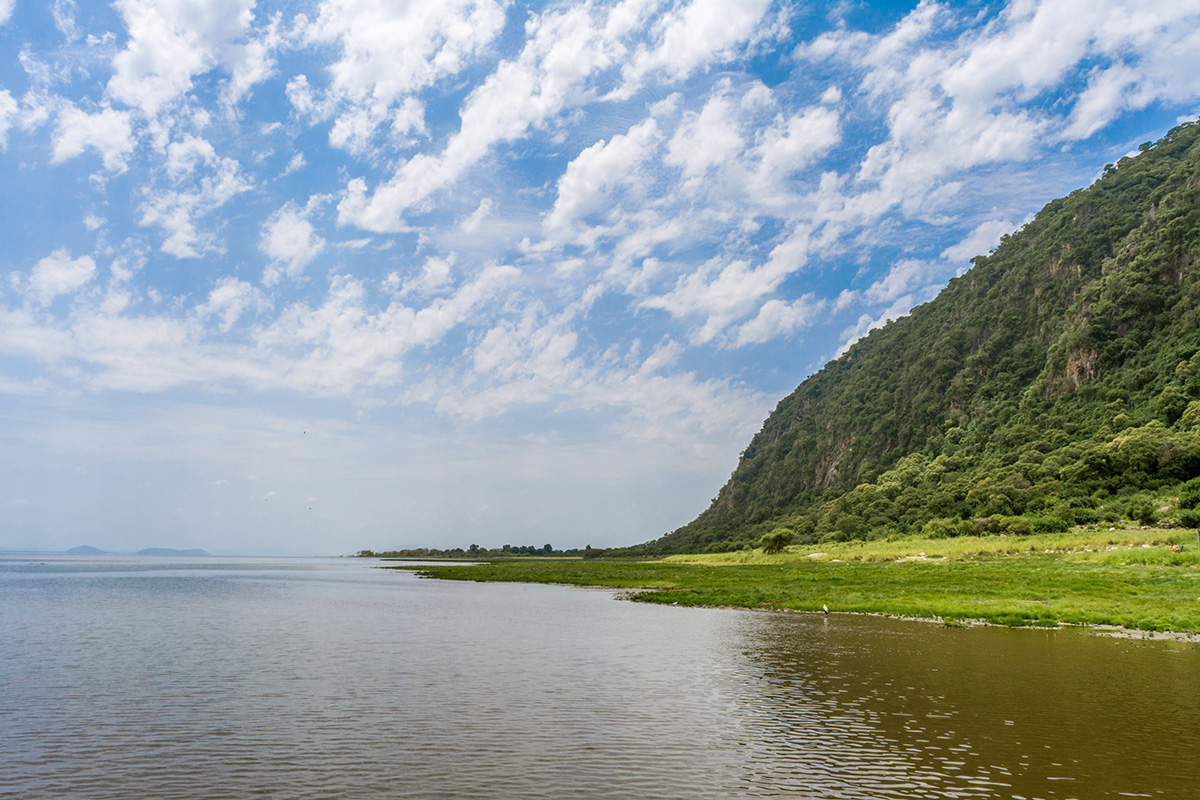
Baboons
From the entrance gate, the road winds through an expanse of lush jungle-like groundwater forest where hundred-strong baboon troops lounge nonchalantly along the roadside, blue monkeys scamper nimbly between the ancient mahogany trees, dainty bushbuck tread warily through the shadows, and outsized forest hornbills honk cacophonously in the high canopy.
Contrasting with the intimacy of the forest is the grassy floodplain and its expansive views eastward, across the alkaline lake, to the jagged blue volcanic peaks that rise from the endless Maasai Steppes. Large buffalo, wildebeest and zebra herds congregate on these grassy plains, as do giraffes, some so dark in coloration that they appear to be black from a distance.
Tree-climbing lions
Inland of the floodplain, a narrow belt of acacia woodland is the favoured haunt of Manyara’s legendary tree-climbing lions and impressively tusked elephants. Squadrons of banded mongoose dart between the acacias, while the diminutive Kirk’s dik-dik forages in their shade. Pairs of klipspringers are often seen silhouetted on the rocks above a field of searing hot springs that steams and bubbles adjacent to the lakeshore in the far south of the park.
Birding
Manyara provides the perfect introduction to Tanzania’s birdlife. More than 400 species have been recorded, and even a first-time visitor to Africa might reasonably expect to observe 100 of these in one day. Highlights include thousands of pink-hued flamingos on their perpetual migration, as well as other large water birds such as pelicans, cormorants, and storks.
NGORONGORO CRATER
The Ngorongoro crater is a part of the larger Ngorongoro Conservation Area and often referred to as one of the wonders of the natural world. This crater was once an active volcano until an eruption a few million years in the past blew its cap off, to give the world its largest unbroken caldera encompassing over 260 square kilometres. The Ngorongoro crater was initially a part of the Serengeti national park but was later separated from it in 1959.
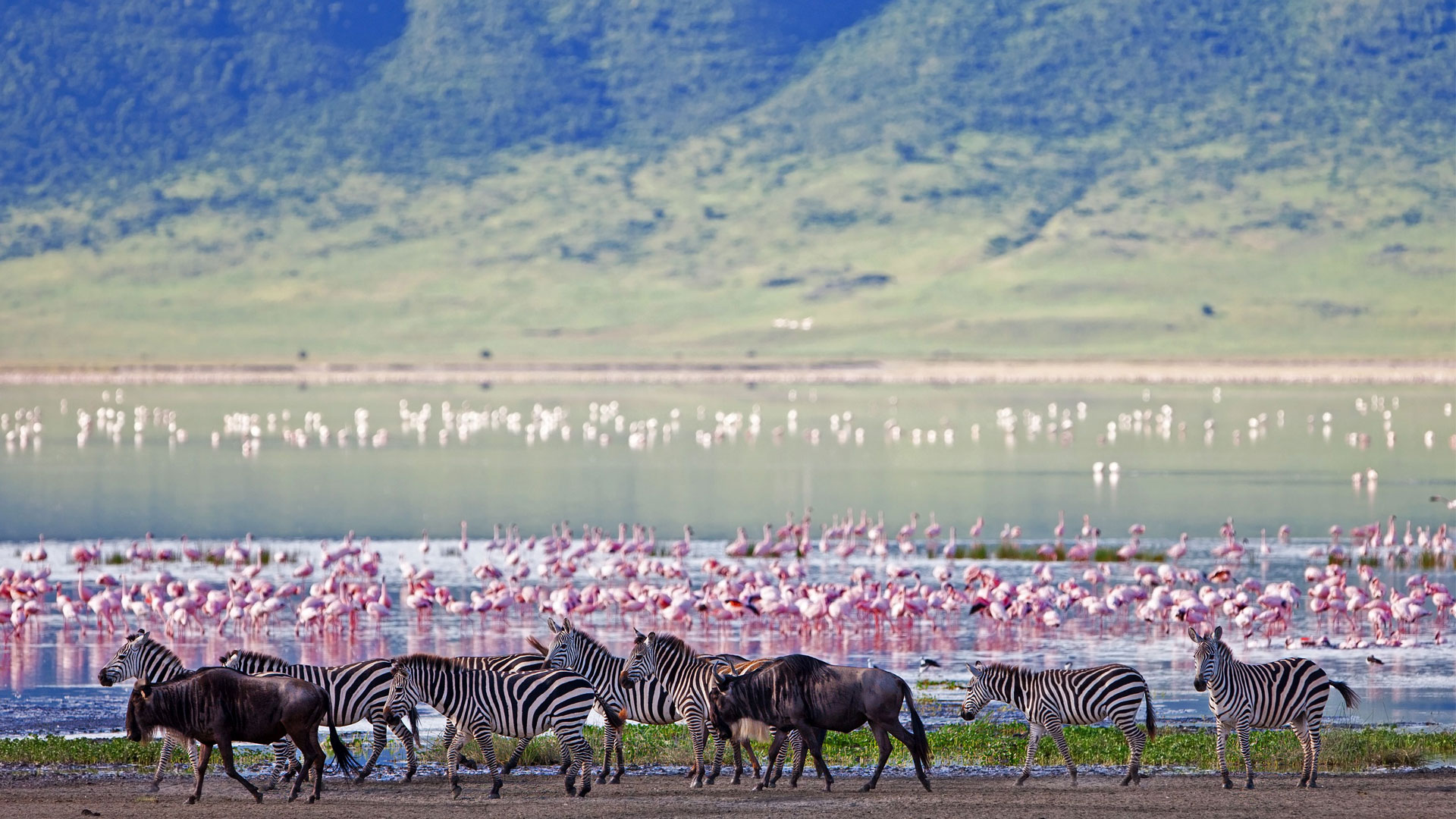
Big Five
The crater is home to the charismatic large animals known as the “big five” and to smaller mammals like the serval, civet, genet, and caracal. It is also well known as a haven for the much-endangered black rhino. Popularly called “The Garden of Eden”, there really is no place like the Ngorongoro crater anywhere on earth!
Olduvai Gorge
Beyond the crater rim, Maasai pastoralists herd their cattle across the plains, seemingly oblivious to the herds of wild animals sharing this vast landscape, the ‘endless plains’ of Serengeti. This truly magical place is home to Olduvai Gorge, where the Leakeys discovered the hominoid remains of a 1.8-million-year-old skeleton of Australopithecus boisei, one of the distinct links of the human evolutionary chain. In a small canyon just north of the crater, the Leakeys and their team of international archaeologists unearthed the ruins of at least three distinct hominoid species, and also came upon a complete series of hominoid footprints estimated to be over 3.7 million years old. Evacuated fossils show that the area is one of the oldest sites of hominoid habitation in the world.
Hiking
Hikes in the highlands head northeast of Ngorongoro Crater towards two smaller craters, Olmoti and Empakai and can continue on to the active volcano Ol Doinyo Lengai (mountain of God to the Maasai) and Lake Natron. Most of the hiking is done on cattle trails alongside the warriors and their herds and nights spent camping amongst Maasai bomas, allowing visitors to interact with the Maasai in their own environment and learn their culture. Exploring this little visited part of the country is an adventure of a lifetime.
SERENGETI NATIONAL PARK
A million wildebeest… each one driven by the same ancient rhythm, fulfilling its instinctive role in the inescapable cycle of life: a frenzied three-week bout of territorial conquests and mating; survival of the fittest as 40km long columns plunge through crocodile-infested waters on the annual exodus north; replenishing the species in a brief population explosion that produces more than 8,000 calves daily before the 1,000 km pilgrimage begins again.
Tanzania’s oldest and most popular national park, also a world heritage site and recently proclaimed a 7th worldwide wonder, the Serengeti is famed for its annual migration, when some six million hooves pound the open plains, as more than 200,000 zebra and 300,000 Thomson’s gazelle join the wildebeest’s trek for fresh grazing.
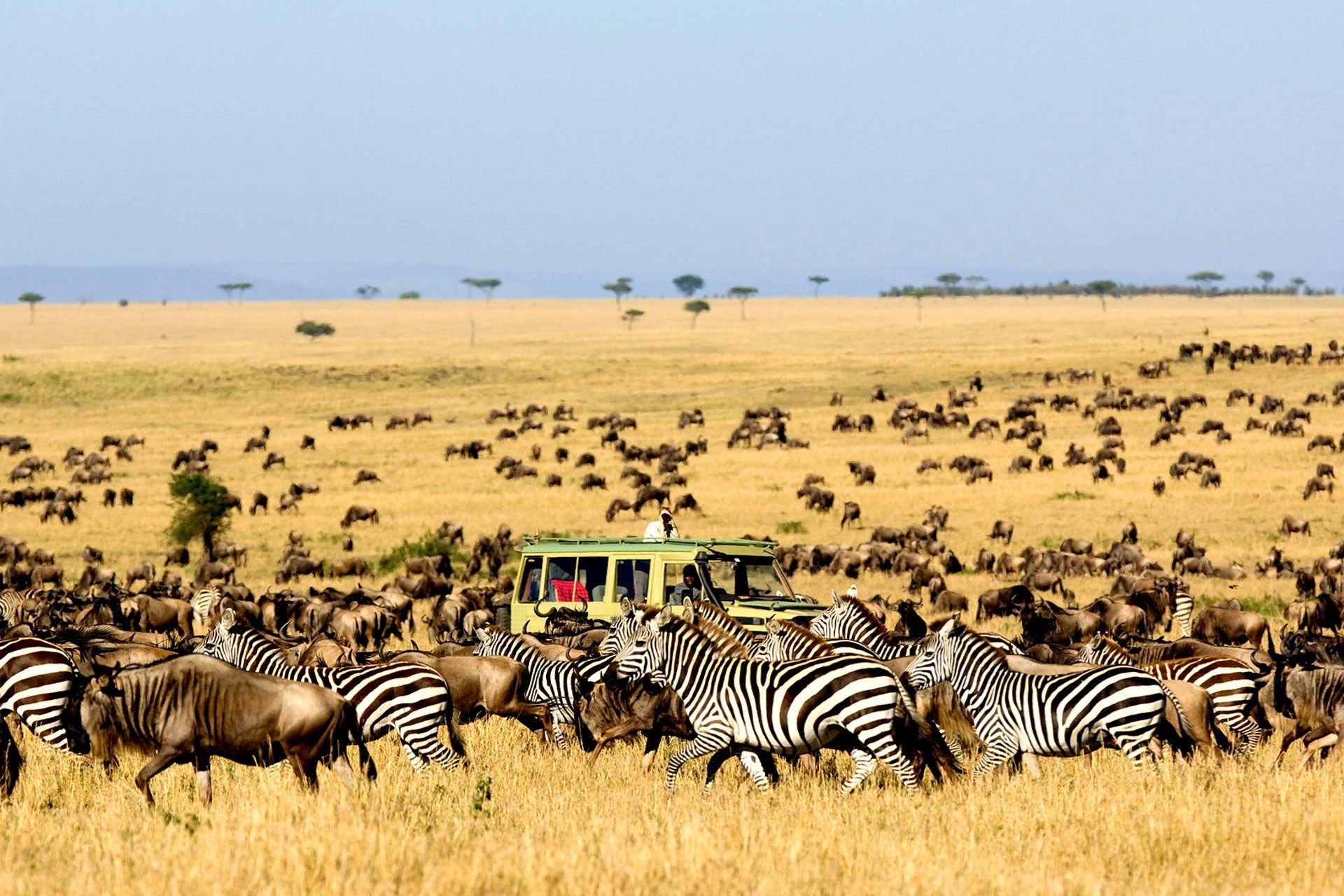
The most amazing game-viewing
Yet even when the migration is quiet, the Serengeti offers arguably the most scintillating game-viewing in Africa: great herds of buffalo, smaller groups of elephant and giraffe, and thousands upon thousands of eland, topi, kongoni, impala and Grant’s gazelle.
The spectacle of predator versus prey dominates Tanzania’s greatest park. Golden-maned lion prides feast on the abundance of plain grazers. Solitary leopards haunt the acacia trees lining the Seronera River, while a high density of cheetahs prowls the south-eastern plains. Almost uniquely, all three African jackal species occur here, alongside the spotted hyena and a host of more elusive small predators, ranging from the insectivorous aardwolf to the beautiful serval cat.
But there is more to Serengeti than large mammals. Gaudy agama lizards and rock hyraxes scuffle around the surfaces of the park’s isolated granite kopjes. A full 100 varieties of dung beetle have been recorded, as have 500-plus bird species, ranging from the outsized ostrich and bizarre secretary bird of the open grassland to the black eagles that soar effortlessly above the Lobo Hills.
From sun-burnt savannah to green carpet
As enduring as the game-viewing is the liberating sense of space that characterizes the Serengeti Plains, stretching across sun burnt savannah to a shimmering golden horizon at the end of the earth. Yet, after the rains, this golden expanse of grass is transformed into an endless green carpet flecked with wildflowers. And there are also wooded hills and towering termite mounds, rivers lined with fig trees and acacia woodland stained orange by dust.
Popular the Serengeti might be, but it remains so vast that you may be the only human audience when a pride of lions masterminds a siege, focused unswervingly on its next meal.
LAKE NATRON GAME CONTROLLED AREA
Pure nature in a virgin land of ancient origin. Wild and remote Lake Natron lies in the northeast of Tanzania in between the Ngorongoro Highlands and Serengeti plains, situated at the base of Africa’s only active volcano Ol dDoinyo Lengai (Mountain of God). Located in the beautiful Maasai Steppe, the Lake Natron Game Controlled Area is marked by the two volcanoes, Mount Gelai and Lengai. Lake Natron itself is a soda lake that attracts an abundance of bird life including thousands of flamingos. The area hosts a pristine forest reserve and grass plains that extend into the Rift Valley. The Natron plains area is covered with classic flat-topped acacia trees, interspersed by mountains, rocky hills, and scenic sand rivers.
This Maasai land area is known for its Grant’s gazelle, gerenuk, lesser kudu, fringe-eared oryx, leopard, Thomson’s gazelle, dik-dik, zebra, wildebeest, ostrich, impala, klipspringer, eland, stein buck, jackal, baboon and Chandler’s mountain reedbuck. Here it is the landscape rather than the animals that is the attraction. The area around the lake is dry, desolate, and hauntingly beautiful.
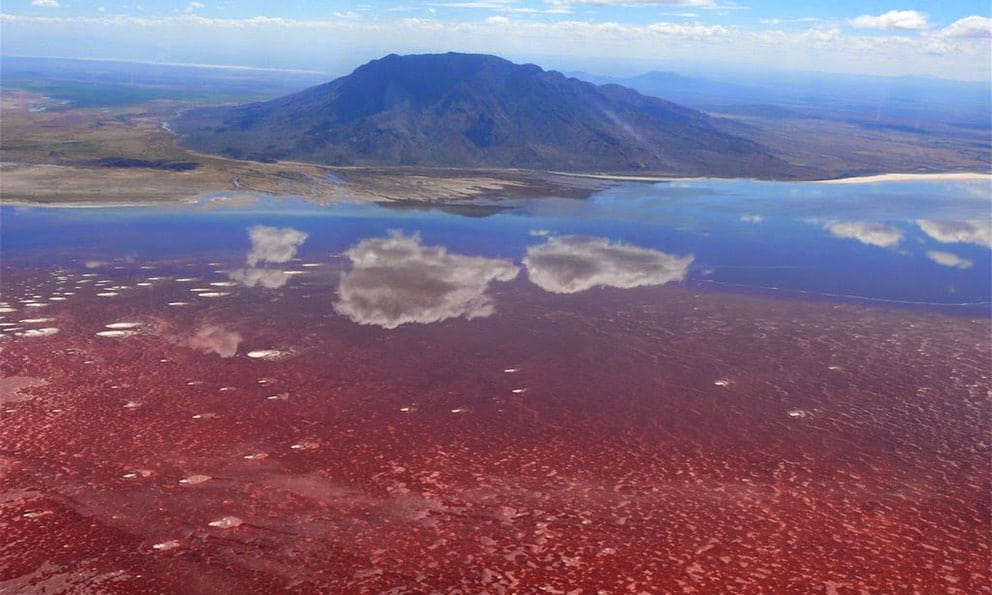
MOUNT KILIMANJARO
Kilimanjaro. The name itself is a mystery wreathed in clouds. It might mean Mountain of Light, Mountain of Greatness or Mountain of Caravans. Or it might not. The local people, the Wachagga, don’t even have a name for the whole massif, only Kipoo (now known as Kibo) for the familiar snowy peak that stands imperious, overseer of the continent, the summit of Africa.
Kilimanjaro, by any name, is a metaphor for the compelling beauty of East Africa. When you see it, you understand why. Not only is this the highest peak on the African continent; it is also the tallest free-standing mountain in the world, rising in breathtaking isolation from the surrounding coastal scrubland, elevation around 900 metres, to an imperious 5,895 metres (19,336 feet).
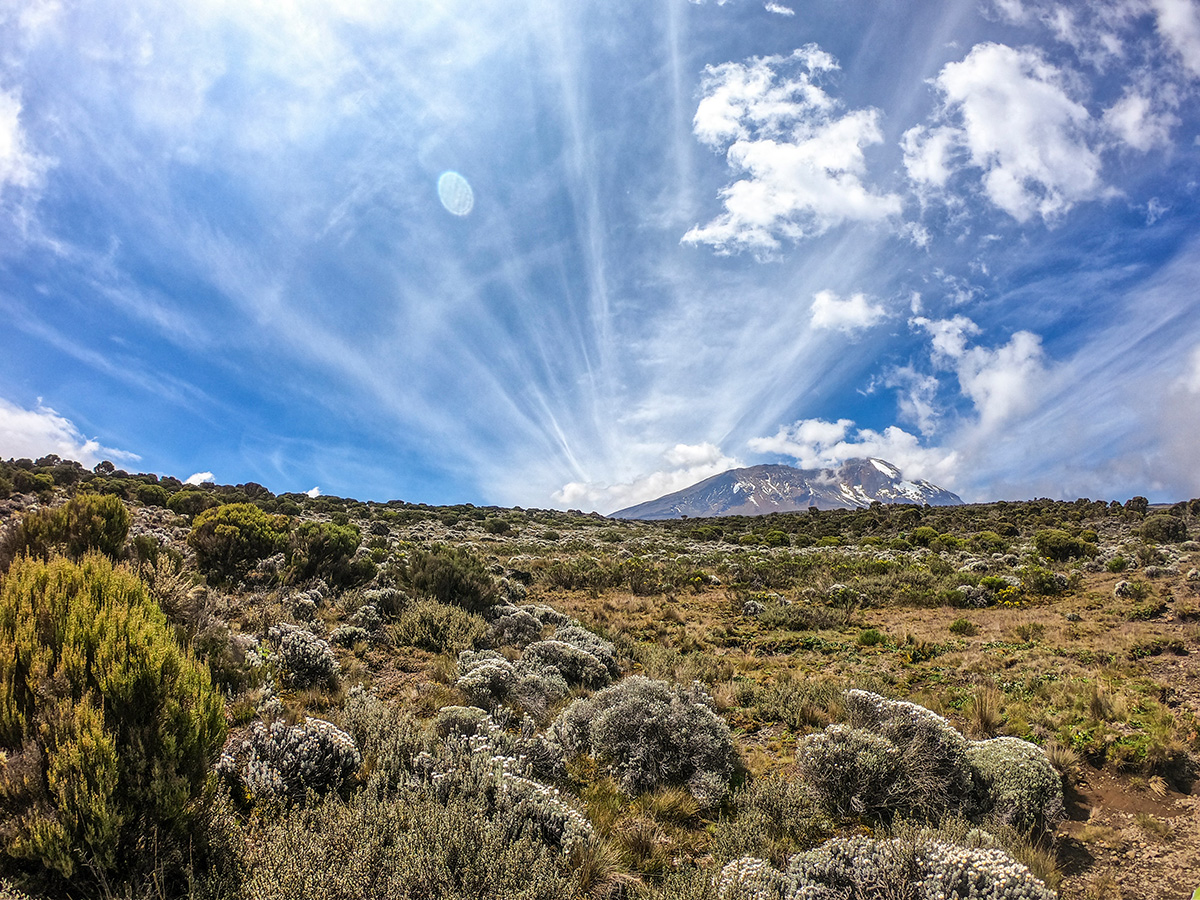
Uhuru Point
Kilimanjaro is one of the world’s most accessible high summits, a beacon for visitors from around the world. Most climbers reach the crater rim with little more than a walking stick, proper clothing, and determination. And those who reach Uhuru Point, the actual summit, or Gillman’s Point on the lip of the crater, will have earned their climbing certificates. And their memories…
But there is so much more to Kili than her summit. The ascent of the slopes is a virtual climatic world tour, from the tropics to the Arctic. Even before you cross the national park boundary (at the 2,700m contour), the cultivated foot slopes give way to lush montane forest, inhabited by elusive elephant, leopard, buffalo, the endangered Abbot’s duiker, and other small antelope and primates. Higher still lays the moorland zone, where a cover of giant heather is studded with otherworldly giant lobelias.
Above 4,000m, a surreal alpine desert supports little life other than a few hardy mosses and lichen. Then, finally, the last vestigial vegetation gives way to a winter wonderland of ice and snow – and the magnificent beauty of the roof of the continent.
MOUNT MERU
The surroundings are awe-inspiring but inspire a lot of fear as well. To the left, the soft black volcanic sand slopes away at an almost 45° angle until, many hundreds of metres below, it plummets over a completely vertical cliff-face. To the right, the same steep open sand slope extends down to the tree line far, far below. An awesome experience, walking along a knife-edge ridge, as screaming winds threatens to blow you off your path down to the forest.
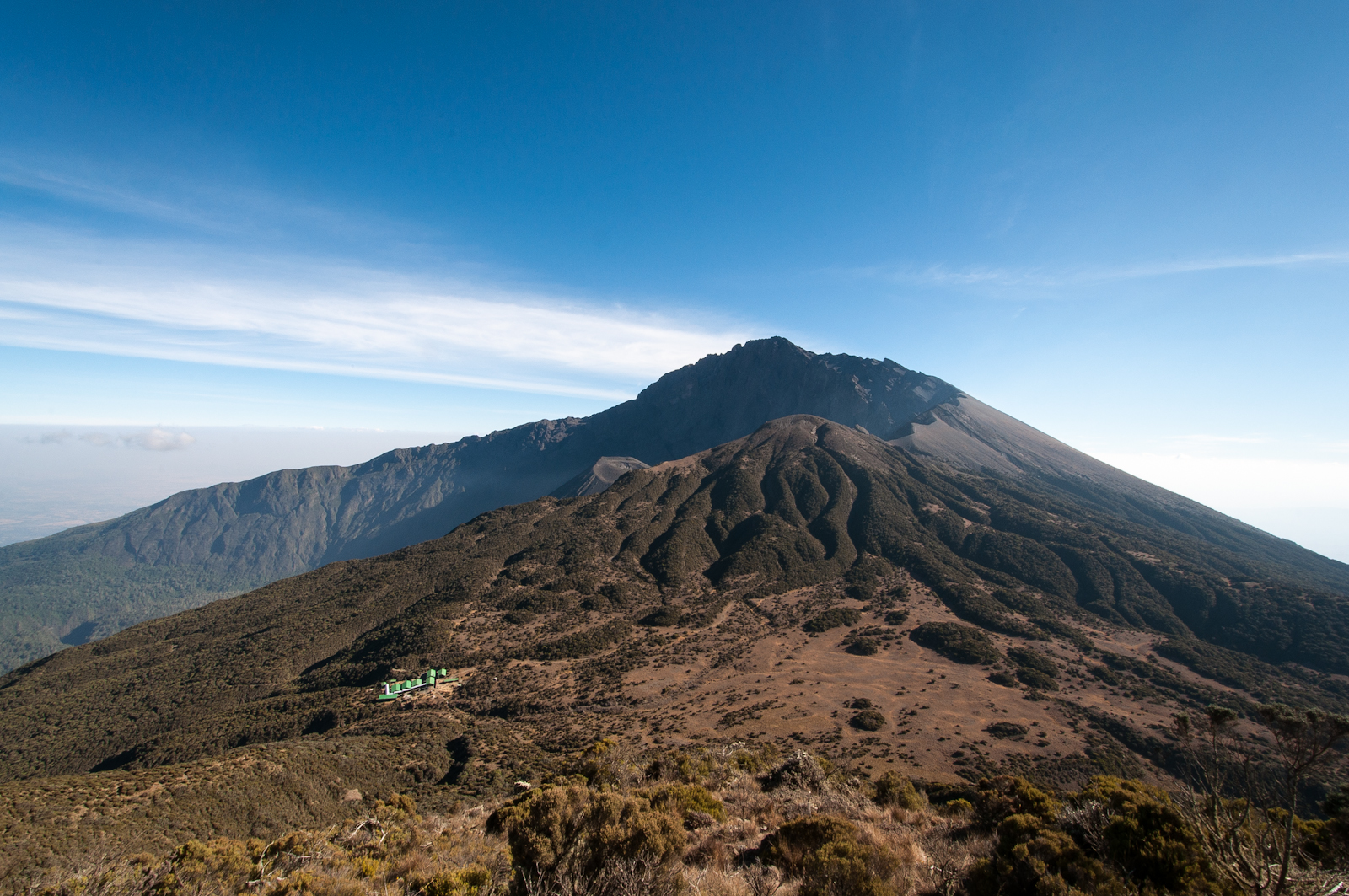
Ancient vulcano
Meru is a spectacular vulcano. Once upon a very long time ago, it rose higher than the Kilimanjaro, the legend says. However tall it once was, it certainly erupted sideways a few million years ago, leaving the northern, southern, and western slopes intact, but obliterating the eastern slope of the volcanic cone. From above, Meru is now shaped like a horseshoe opening east, with a tiny new cinder cone forming in the bottom of the devastated crater, and huge cliffs extending up the crater walls almost to the summit. The crater floor and the lower slopes are densely forested, but the upper slopes are barren expanses of black volcanic ash and occasional massive boulders of lava.
Climbing the Meru
Mount Meru is one of Africa’s most beautiful volcanoes, and it is the second highest mountain in Tanzania at 4,5685m, the fifth highest in Africa. The mountain is located within Arusha National Park, Tanzania’s gem. This prime location gives walkers the opportunity to spot some of the birds and wildlife that inhabit the area. The ascend is quite steep, the route to the summit passes over streams, through parkland, montane forest, a giant heather zone, and moorland. The summit is reached by a narrow, barren ridge, which provides stunning views of the Ash Cone lying several thousand feet below in the crater. Weather permitting, Kilimanjaro can be seen in the West. There are two huts available to climbers on the mountain and firewood is supplied. The best time to climb Meru is between October and February. But also June to September, while it is colder then.
NYERERE NATIONAL PARK
Wild, beautiful, and numerous. Originating from the Rufiji River – the park’s lifeline – a network of channels, lakes, lagoons, sandbanks, and swamps form one of Africa’s most outstanding ecological systems – giving life to abundant game, extraordinary birdlife and vast, thriving, untouched wilderness.
Nyerere National Park (formerly part of the Selous Game reserve, the largest nature reserve in Africa and the second largest in the World), abounds in open space and liberty: fifty-five thousand square kilometres that enjoy the most unreserved luxury that one can dream of a rich and constant river. Within the park no permanent human habitation or permanent structures are permitted. All (human) entry and exit is carefully controlled by the Wildlife Division of the Tanzanian Ministry of Natural Resources and Tourism.
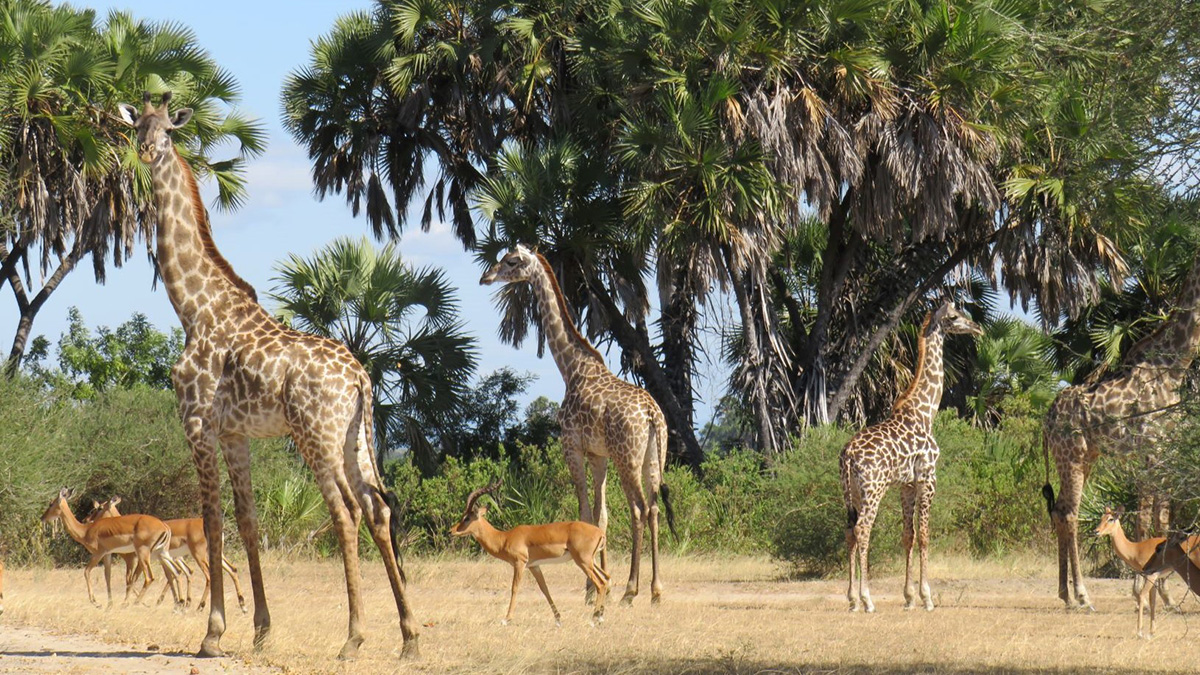
Numerous mammals
Over 800,000 mammals, including lions, leopards, cheetahs, elephants, buffalos, zebras, impalas, gnus, hartebeests, waterbucks, giraffes, kudus, warthogs, grysbok, hyenas, jackals, wild dogs, bush babies, baboons, Vervet monkeys and mongooses. And that’s without mentioning the park’s specialty – an abundance of hippopotamuses and crocodiles.
Birdlife
At least 440 bird species are documented residents of the park, but there are surely more to discover as in a large part of the reserve few or no men have set foot. The sight of the innumerable birds that enliven the park is breath-taking: yellow-billed storks, marabou storks, spoonbill stocks, Goliath herons, ibises, gray herons, egrets and pelicans as well as weaves, starlings, geese, ducks and numerous birds of prey like eagles, falcons, kites, etc.
Unforgettable landscapes
In Nyerere there is such a variety of environments that in a single day it’s possible to pass from the bush to open savannah, to the Borassus palm of the more temperate riverbanks. On foot, on boat, every day, every hour, every season reserves incredible surprises: never-ending skies, flaming sunsets, nights in which the moon seems electrified, mountains, plains, dense bush, unending green fields interrupted only by a pair of umbrella-like acacias, the enormous river with groups of playful hippos… Animals in liberty, running happily in the richness of their uncontaminated environment.
MIKUMI NATIONAL PARK
Mikumi was made a National Park in 1964 and is 3,230 sq. km (1,250 sq. miles) in size. This enormous area links the Nyerere National Park (formerly Selous) with the forested abundance of the eastern arc mountains, and so is an important part of a huge ecosystem of rivers, flood plains, forests, and woodlands. The northern plains that surround the Mkata River are readily accessible and is the best place to go for wildlife. A good network of tracks means that a wide variety of
wildlife including buffalo, cape hunting dog, cheetah, and lion are approachable and can be enjoyed at close quarters.
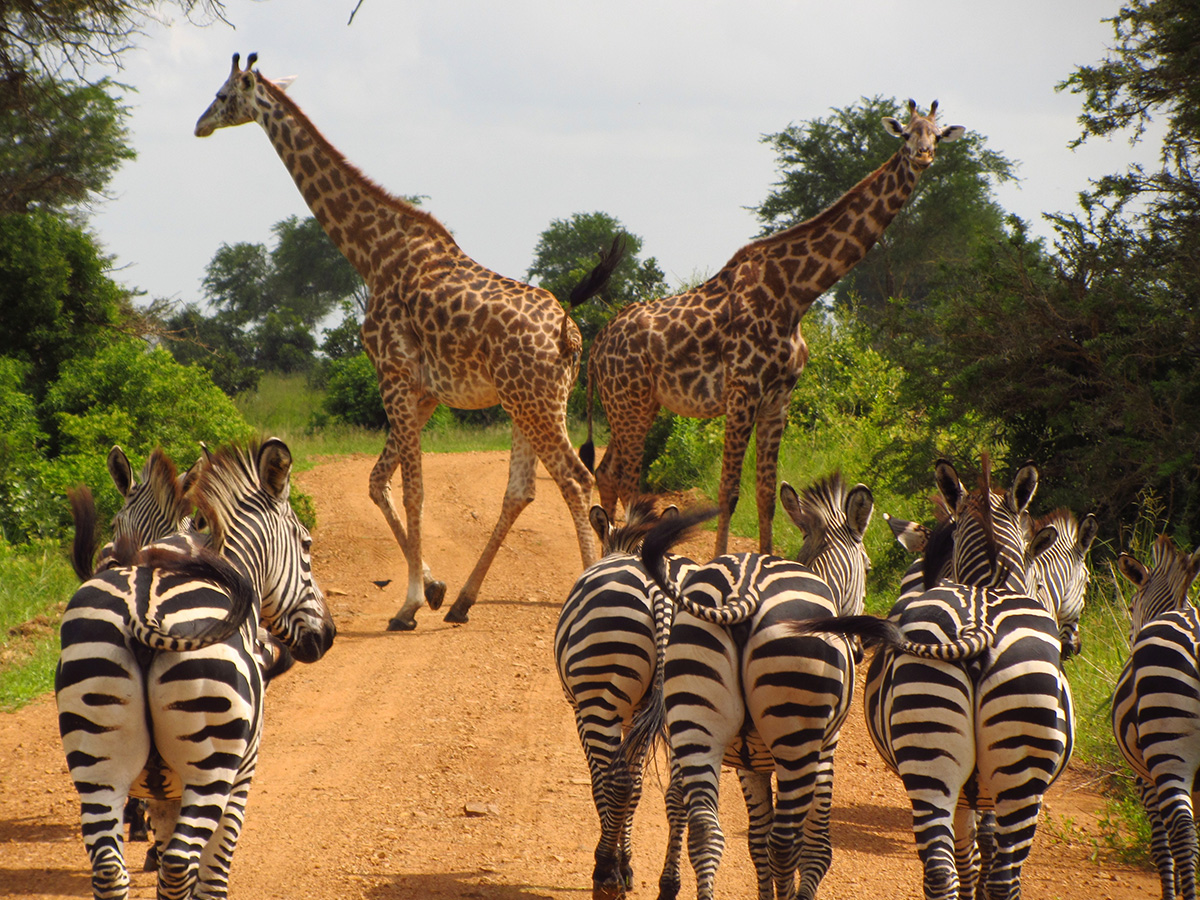
Wildlife
Mikumi abounds with big game, including buffalo, elephant, the big cats, hippo, crocodile, giraffe, zebra, eland as well as smaller species. Some of the more unusual species such as sable antelope, Lichtenstein’s hartebeest and greater kudu inhabit the wooded areas surrounding the Mkata plains and are more of a challenge to find. But they’re there!
RUAHA NATIONAL PARK
If you can only see one park in Tanzania, it should be the Ruaha National Park. The combination of stunning scenery, rugged landscapes, and animal variety is unmatched. The game viewing starts the moment the plane touches down. A giraffe races beside the airstrip, all legs and neck, yet oddly elegant in its awkwardness. A line of zebra’s parades across the runway in the giraffe’s wake. In the distance, beneath a bulbous baobab tree, a few representatives of Ruaha’s 10,000 elephants – the largest population of any east African national park- form a protective huddle around their young.
Rivers, mountains, plains, rock kopjes, swamps, dense woodlands, open savannas spread out across an immense landscape that has barely been touched by man. Wooded hillsides, many with rounded granite outcrops and scatterings of huge baobabs, are dissected by sandy, rock-strewn seasonal rivers and streams running down to meet flood plains and seasonal swamps, many of which end up in the Great Ruaha River.
Seasonal rivers are lined by scattered groves of palms, thorn trees, fig trees and sausage trees providing midday shade for all sorts of wild animals. They are key features to enjoy during game drives, especially during the dry season when only pools remain, or the elephants have to dig in the sand for water. This is Africa of a bygone era – the world as it was before modern man.
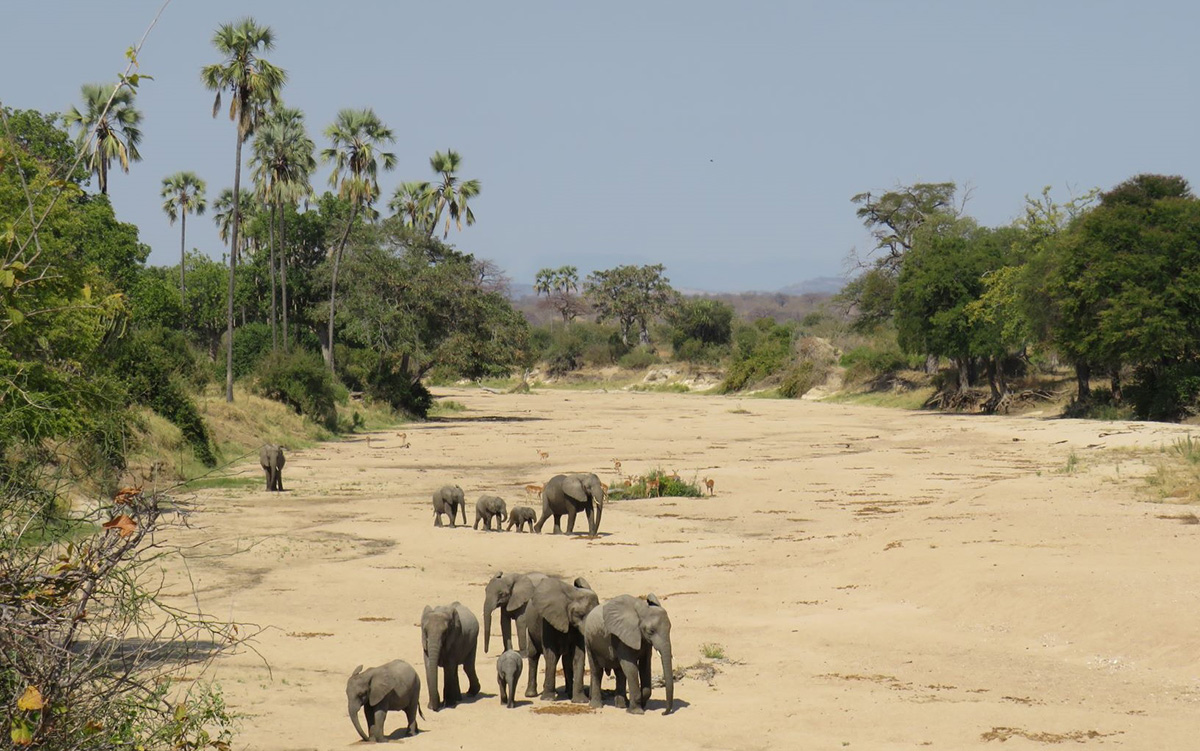
Wildlife
Wildlife is especially varied because of the overlap of eastern and southern African wildlife zones, so besides regular big game such as elephant, buffalo, and plains animals, the more unusual species such as the sable antelopes, roan, greater and lesser kudu are quite common. Cape hunting dog are also often encountered. Ruaha is also a great place for the big cats, lion, leopard, and cheetah.
Birdlife is also understandably rich. In fact, outstandingly so with over 550 species having been recorded, and an enormous variety of birds of prey.
ZANZIBAR
Zanzibar Archipelago, located in the Indian Ocean 15 miles off the coast of Tanzania and made up of Zanzibar and Pemba Islands, and several islets, is a breath-taking spot to escape from the world. Steeped in culture and history, Zanzibar enticed adventurers, seafarers, and traders from far and wide. Known as the spice island, from the centuries old trade of cloves, nutmeg, and cinnamon, today the Zanzibar Archipelago is still bathed in the heady scents of spices and traditional dhows still drift across the horizon.
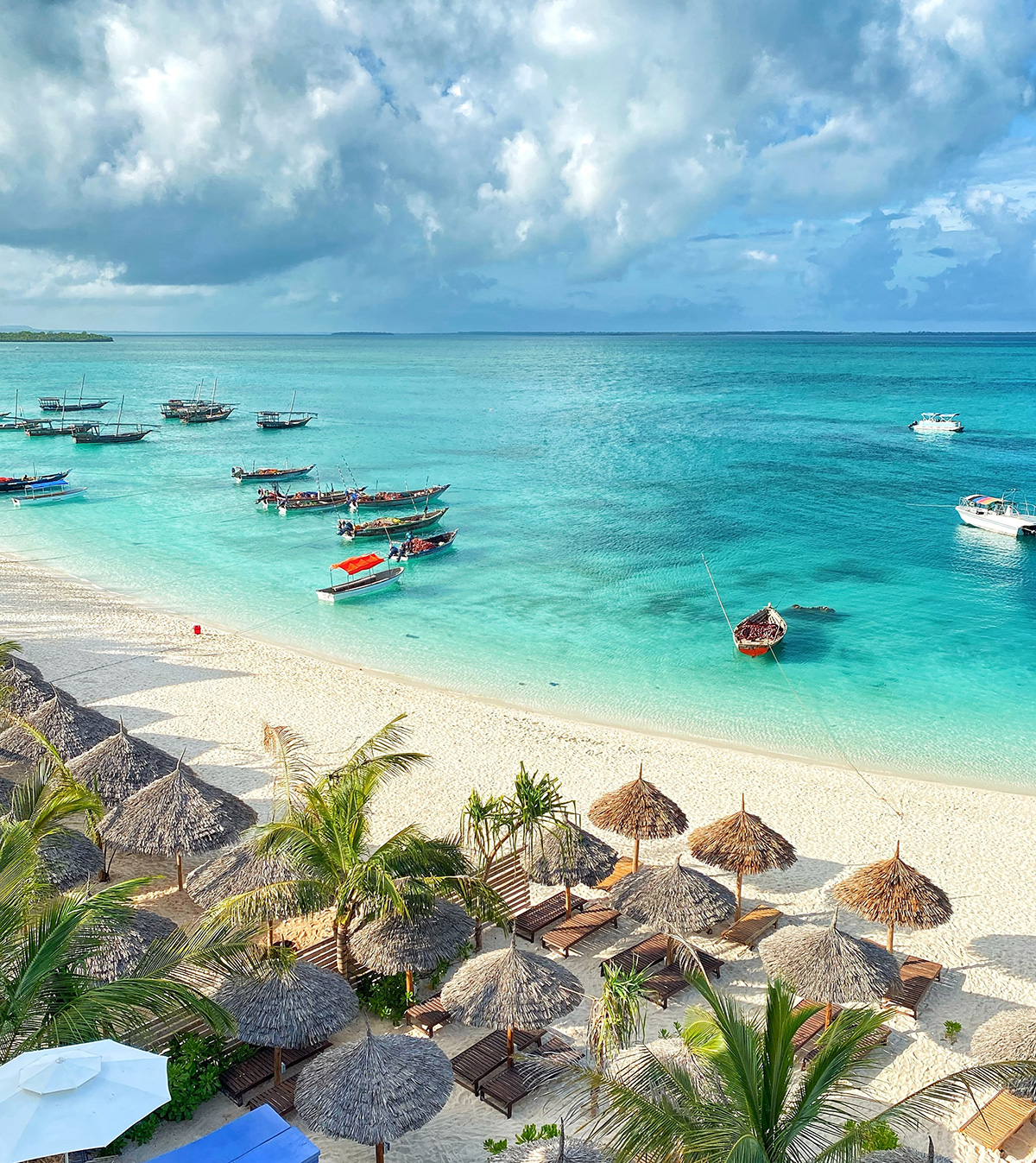
Stone Town: the capital
It may not have a particularly romantic name, but Stone Town is the old city and cultural heart of Zanzibar, little changed in the last 200 years. It is a place of winding alleys, bustling bazaars, mosques, and grand Arab houses whose original owners vied with each other over the extravagance of their dwellings. This one-upmanship is particularly reflected in the brass-studded, carved, wooden doors – there are more than 500 different examples of this handiwork. You can spend many idle hours and days just wandering through the fascinating labyrinth of narrow streets and alleyways. Stone Town was recently and deservedly declared a World Heritage Site by UNESCO. More information can be found at the UNESCO website.
Most of the houses that can be seen today were built in the 19th century when Zanzibar was one of the most important trading centres in the Indian Ocean region. The coralline rock of Zanzibar was a good building material, but it is also easily eroded. This is evident by the large number of houses that are in a bad state of repair. Several buildings have already been renovated and the Stone Town Conservation Authority has been established to co-ordinate the restoration of the town to its original magnificence.
Paradise beaches
Zanzibar’s brilliant white beaches lapped by the warm turquoise waters of the Indian Ocean provide the perfect place to relax, soak up the sun and take a break from some busy sightseeing. The beaches in Zanzibar are a paradise, interspersed with picturesque fishing villages, where the people live a simple way of life, unchanged over the years. There are more than 25 fantastic beaches in Zanzibar, and some are so peaceful and remote that the only noise breaking the silence is likely to be the ocean.
The people
Zanzibar’s local people are an incredible mixture of ethnic backgrounds, indicative of her colourful history. Islam is the dominant religion, and practiced by most Zanzibaris, although there are also followers of Christianity and Hinduism. Population is estimated at 800,000, with the largest concentration being Zanzibar City which has approximately 100,000 inhabitants. Zanzibaris speak Swahili (known locally as Kiswahili), a language which is spoken extensively in East Africa. Many believe that the purest form is spoken in Zanzibar as it is the birthplace of the language.
PEMBA ISLAND
Pemba has been separated from the mainland and Zanzibar for decades, leaving an untouched and pristine island of great beauty and fertility. The mosaic of forests, swamps, mangroves, hidden beaches and lagoons is scattered with the ruins of mosques and tombs mostly reclaimed by the forest – sites that date back to Arab domination when Pemba was seized by the Sultan of Muscat (Oman) in the 17th century. He established his court in Zanzibar and ruled Muscat from there.
Pemba is still the world’s major clove producer, around 70% of all cloves deriving from there, but now plays its more traditional role of being an Island Paradise with small inter-island trade.
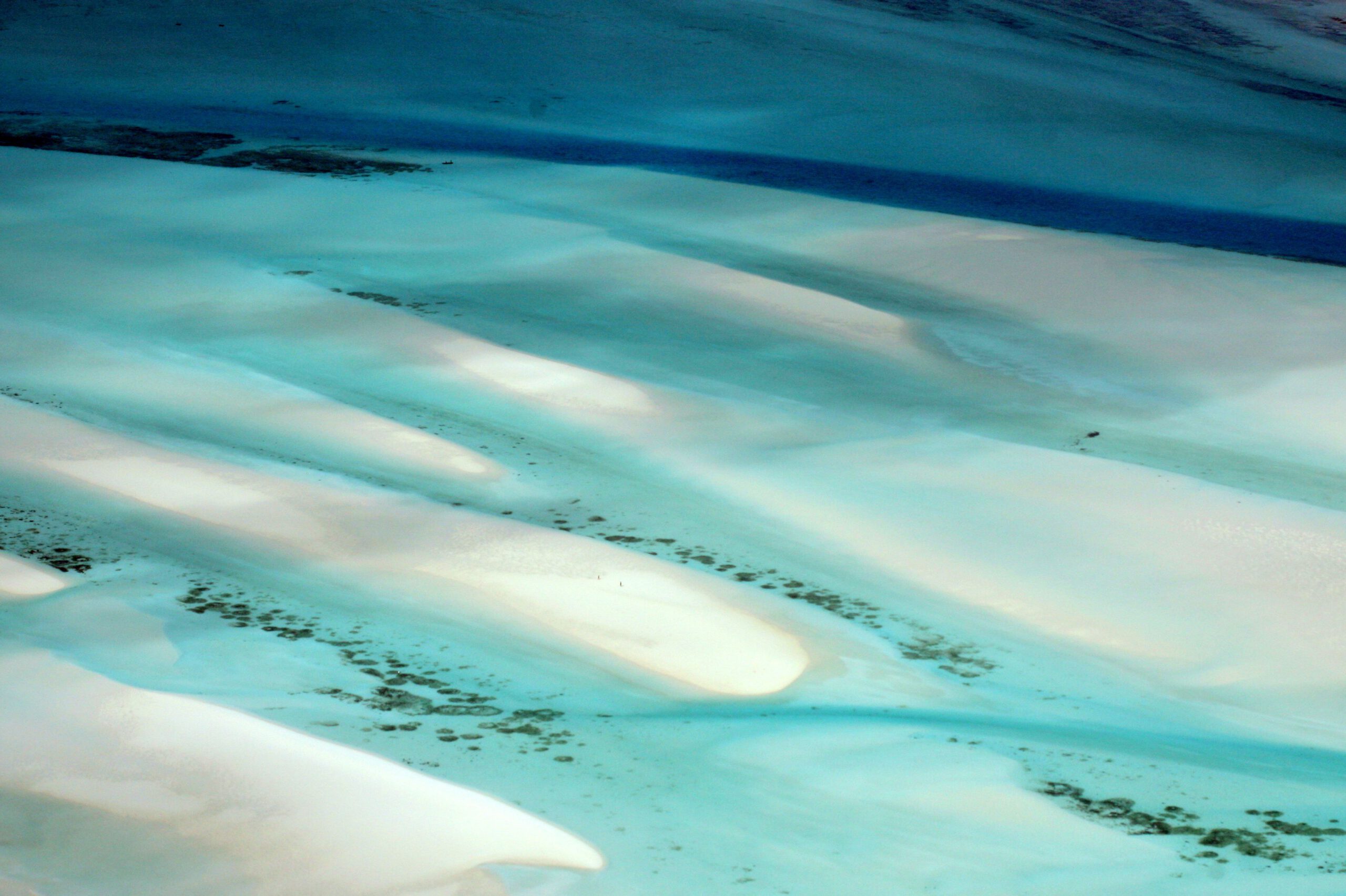
MAFIA ISLAND
The green islands of the Mafia Archipelago are scattered along the coast southeast of Dar es Salaam. They are surrounded by turquoise waters and shimmering white sandbanks. Heading for an active holiday? Would you like to dive and snorkel at one of the most stunning diving locations in the world? In that case, Mafia Island is the perfect location. The island is in fact the largest protected nature reserve in East Africa. You can even snorkel with whale sharks here.
Mafia Island has a friendly and tranquil atmosphere. The locals are mainly concerned with their traditional way of life and don’t care much about the outside world. The island is ideal for divers, but also for sailors and hikers who are looking for the extraordinary.
